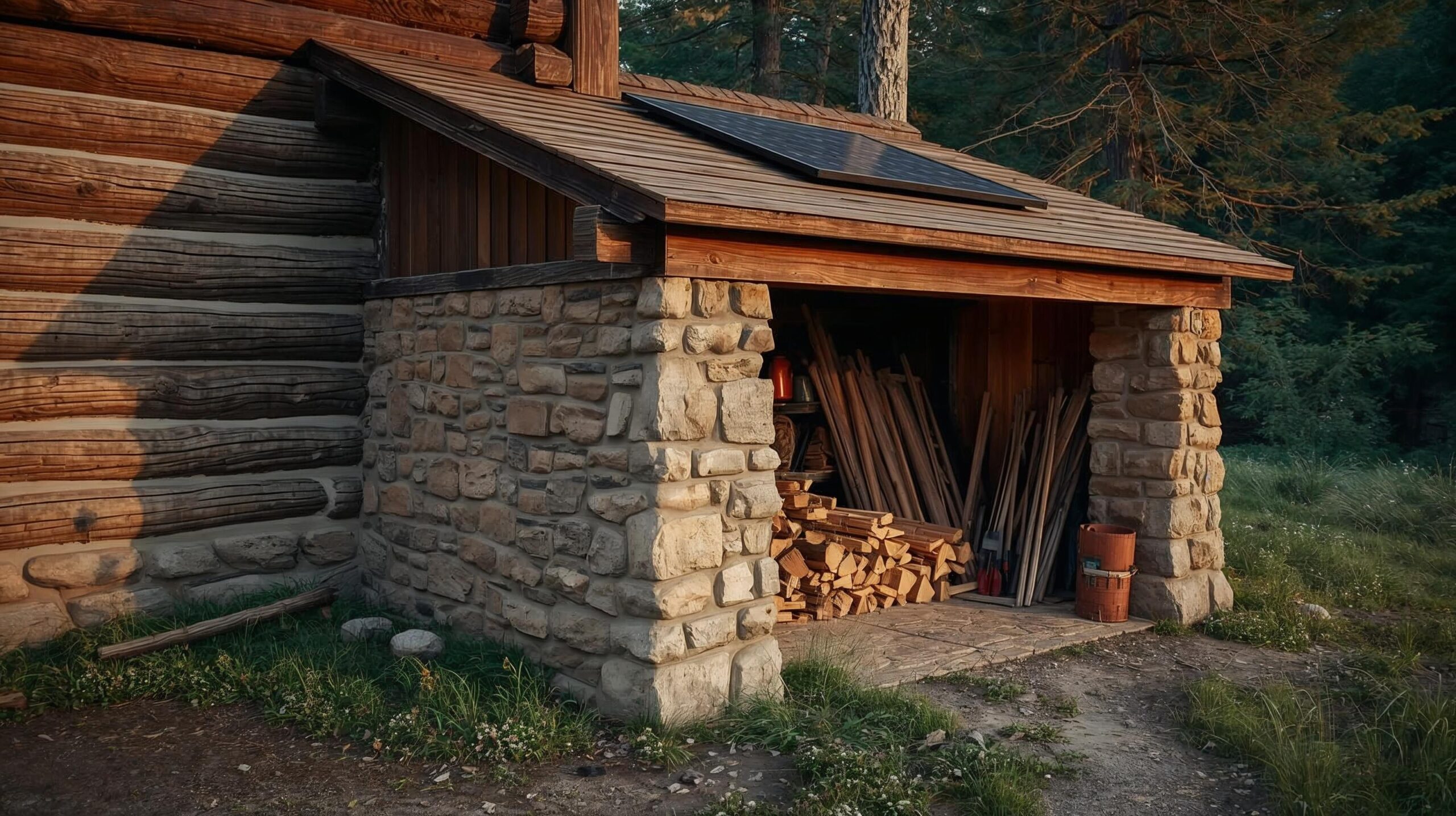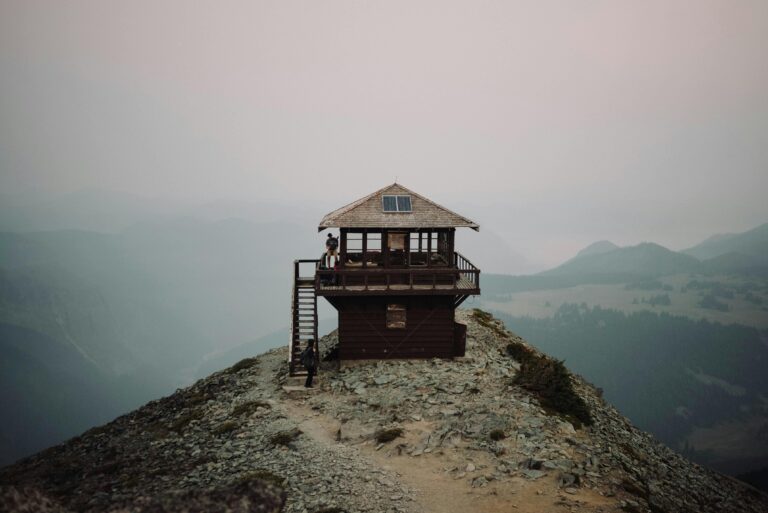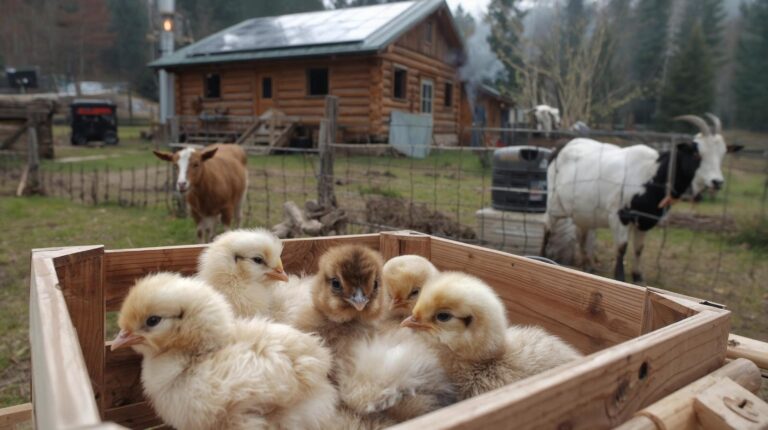Natural Mortar: The Simplest Way to Build with Brick, Stone, or Wood Off-Grid
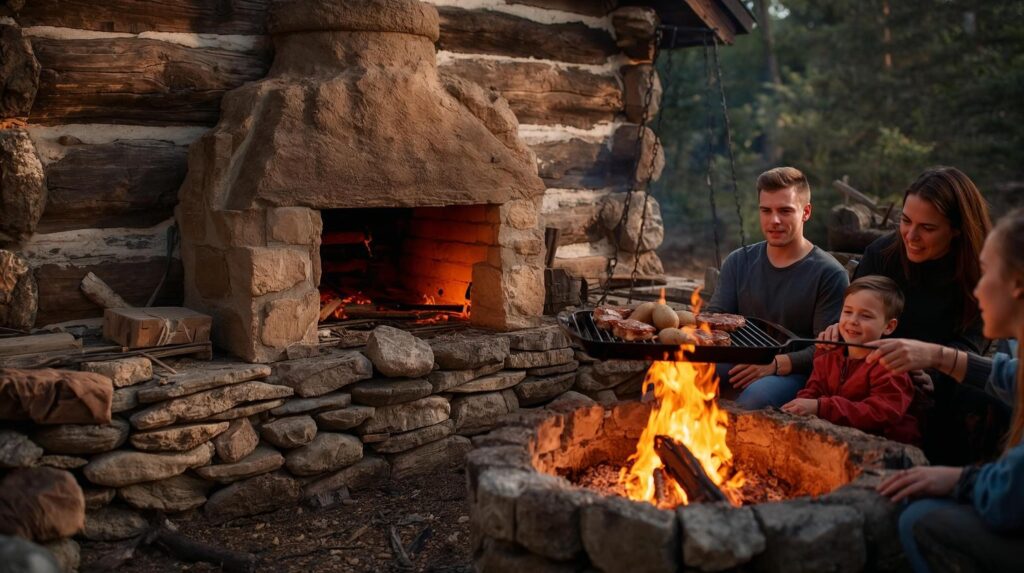
You don’t need cement or fancy equipment to build a solid fire pit, smoker, or shed. Natural mortar—made from clay, sand, and water—has held structures together for thousands of years, and it’s surprisingly easy to make yourself. If you can dig a hole and mix mud, you can do this.
This guide covers three dead-simple mortar recipes using materials you can find on your land. We’ll use a 5-gallon bucket for measurements (no scales or measuring cups needed), and I’ll show you the easiest mixing methods—including just spreading a tarp and stomping it with your feet. The most basic recipe? Just clay, sand, and water. That’s it.
Whether you’re working with bricks, stones, or wood, these recipes work. And if you want to see what’s possible, I’ll share some project ideas at the end. Ready to learn an ancient skill that’s easier than you think?
Why Natural Mortar Works (And Why It’s Worth Learning)
Natural mortar is essentially nature’s adhesive for stacking materials. It’s made from clay (which provides stickiness), sand (which adds strength), and sometimes straw or grass fibers (which prevent cracking). People have used variations of this recipe to build everything from adobe homes to stone walls, and the technique has proven itself over centuries.
The best part? It’s forgiving. If your first batch is too wet, add more sand. Too crumbly? Add clay. The materials are free, you can work at your own pace, and it sets over several days—giving you time to adjust as you build.
For off-grid projects like fire pits, smokers, or small sheds, natural mortar is more than adequate. It won’t match modern cement for heavy structural loads, but for the projects most people tackle on their homestead, it does the job.
Step 1: Find Clay-Rich Soil
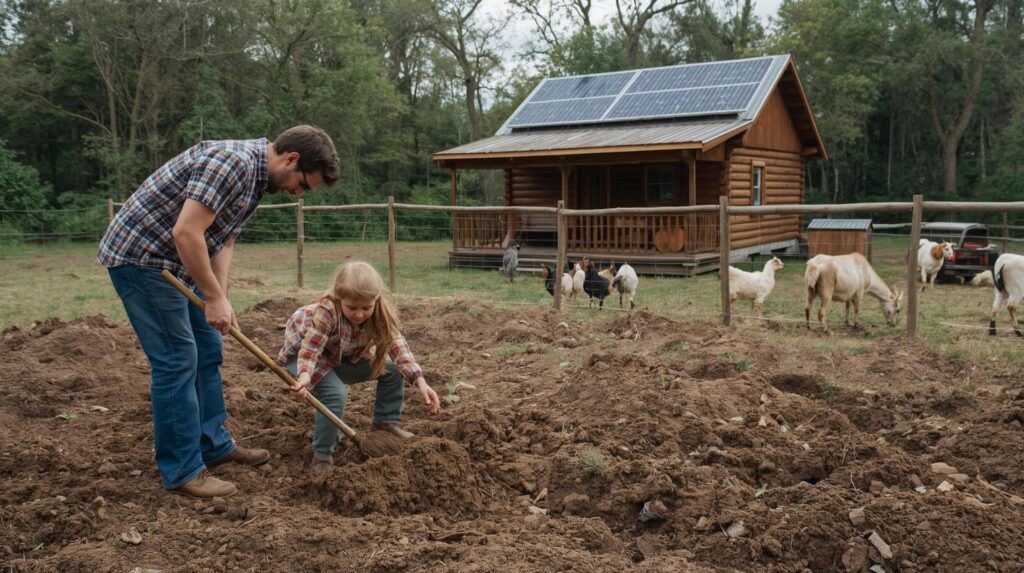
Clay is the key ingredient, and it’s more common than you might think. You’re looking for soil that feels smooth and sticky when wet—not gritty like sand.
Where to Look:
- Low-lying areas where water collects (near creeks, ponds, or drainage spots)
- Dig 1-2 feet down in these areas—clay is usually below the topsoil
- In clay-heavy regions like the Canadian prairies, you might find it almost anywhere you dig
The Squeeze Test:
Grab a handful of damp soil and squeeze it in your fist. If it holds its shape like playdough and feels slick, that’s clay. If it crumbles or feels gritty, keep looking or adjust your recipe later with more clay-rich soil.
If you’re building a shelter or foundation for your water storage tanks, this same mortar recipe works perfectly for creating stable stone or brick bases.
Optional: If you want to get technical, you can do a jar test. Fill a clear jar halfway with soil, add water and a pinch of salt, shake it well, and let it settle for 24 hours. Clay settles as the top layer. If clay makes up about 1/4 of the soil, you’re in good shape.
Tools that help: A basic soil test kit can confirm clay content, or check the USDA’s Web Soil Survey for your area. But honestly, the squeeze test works fine for most people.
Step 2: Gather Your Materials
Everything you need is free and close by. Think of this as a scavenger hunt on your property.
Clay
- Where: Low spots, creek banks, anywhere you found it in Step 1
- How much: Fill a 5-gallon bucket about 1/4 full for a small project (20-30 bricks or stones)
- Prep: Pick out any large rocks by hand
Sand
- Where: Riverbeds, beaches (rinse off salt if coastal), or dry streambeds
- How much: Fill the bucket 3/4 full
- What to look for: Gritty, coarse sand works best—avoid fine dust-like sand if possible
Straw or Grass Fibers (Optional)
- Where: Dried grass from fields, straw from farms, or aged manure (which contains plant fibers)
- How much: 1-2 large handfuls
- Prep: Chop into 1-2 inch pieces
Skip the straw if you want the absolute simplest recipe—it’s not required, just helpful for preventing cracks in larger projects or humid climates.
Lime (Advanced, Rarely Used)
Some traditional recipes call for lime (from burning limestone or shells), which makes the mortar more water-resistant. It’s a more involved process and honestly not necessary for most off-grid projects. Stick with clay-sand recipes unless you’re building in a very wet climate.
Step 3: Mix Your Mortar (Three Proven Recipes)
Here are three recipes, from simplest to slightly more complex. Start with Recipe 1—you can always try the others later.
All measurements use a 5-gallon bucket and are approximate. One bucket of finished mortar covers a small fire pit (20-30 bricks or stones). Mix until it’s the consistency of thick peanut butter—sticky enough to hold, but not soupy.
Easiest Mixing Methods (Pick One)
Tarp Method (My Favorite):
Spread a tarp or old sheet on the ground. Dump your materials on it, then mix by pulling the tarp edges to roll and fold the pile. Add water slowly from a bottle or bucket. The tarp contains the mess and makes cleanup easy.
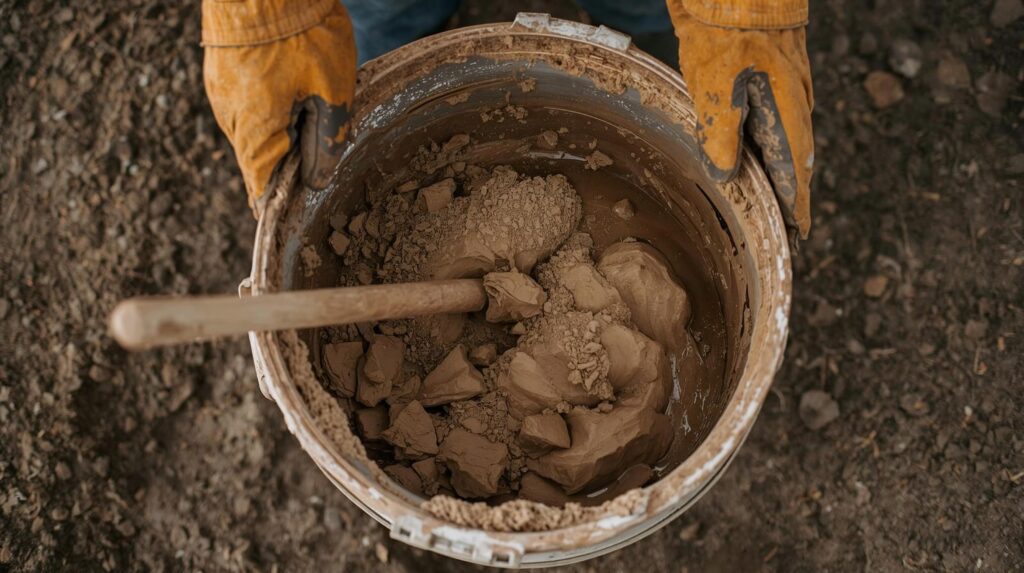
Bucket Method:
Mix directly in your 5-gallon bucket using a sturdy stick or shovel. Stir like you’re making thick soup, adding water bit by bit.
Ground Pit Method:
Dig a shallow pit (1 foot deep, 3 feet wide). Dump materials in and mix by stomping with clean feet or using a stick. This one’s fun if you don’t mind getting dirty.
Pro tip: Mix dry ingredients first, then add water gradually. If it gets too wet, add more sand. Too dry? Add more clay or a splash of water. Let the mix sit for 1-2 days if you want it to spread more easily (this is optional).
Recipe 1: Basic Clay-Sand Mortar (Simplest)
Best for: Dry climates, beginners, fire pits, stone walls
Ingredients:
- 1/4 bucket clay (a few softball-sized lumps)
- 3/4 bucket sand
- 1-2 gallons water (add slowly)
Method:
Break up clay lumps (soak overnight if they’re hard). Use tarp, bucket, or pit method to mix. Add water gradually until the mix is thick and sticky—not runny. Use immediately or let it rest a day for easier spreading.
Why it works: This is the ancient recipe. Just clay, sand, and water. It dries strong and solid for most projects.
Recipe 2: Clay-Sand-Straw Mortar (Most Popular)
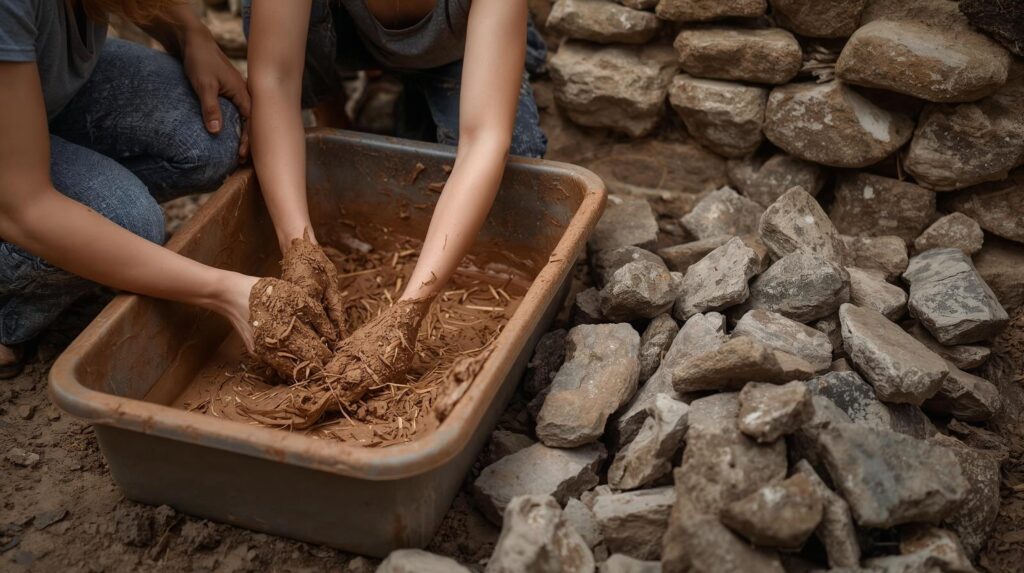
Best for: Larger projects, humid climates, sheds, smokers
Ingredients:
- 1/4 bucket clay
- 3/4 bucket sand
- 1-2 large handfuls chopped straw or grass (about 1/8 bucket)
- 1-2 gallons water
Method:
Chop straw into small pieces. Mix dry ingredients on tarp or in pit/bucket, then add water gradually. Stomp or stir well. Let rest 1-2 days for best results.
Why it works: Straw acts like tiny reinforcing bars, preventing cracks as the mortar dries. This makes it ideal for projects exposed to weather or temperature swings.
Recipe 3: Lime-Sand Mortar (Advanced)

Best for: Very wet climates, projects needing maximum water resistance
Ingredients:
- 1/4 bucket lime putty (made by burning limestone or shells)
- 3/4 bucket sand
- Less than 1 gallon water (lime putty is already wet)
Method:
Making lime is involved—you burn shells or limestone in a fire pit for 24-48 hours, let it cool, then add water to create putty (wear gloves, it’s caustic). Mix with sand on tarp or in bucket. Let age a day before using.
Why it works: Lime mortar sets harder and resists water better than clay-sand. But it’s more work and rarely necessary unless you’re in a very rainy area.
Recommendation: Stick with Recipe 1 or 2 unless you have a specific need for lime.
Using These Recipes for Bricks, Stones, or Wood
All three recipes work for bricks and stones as-is. For wood projects (like shed posts or log frames), use Recipe 2 and make it slightly thicker (less water, more like cookie dough). The straw helps the mortar grip wood’s texture better. Test a small section first to make sure it adheres well.
Step 4: Basic Building Technique
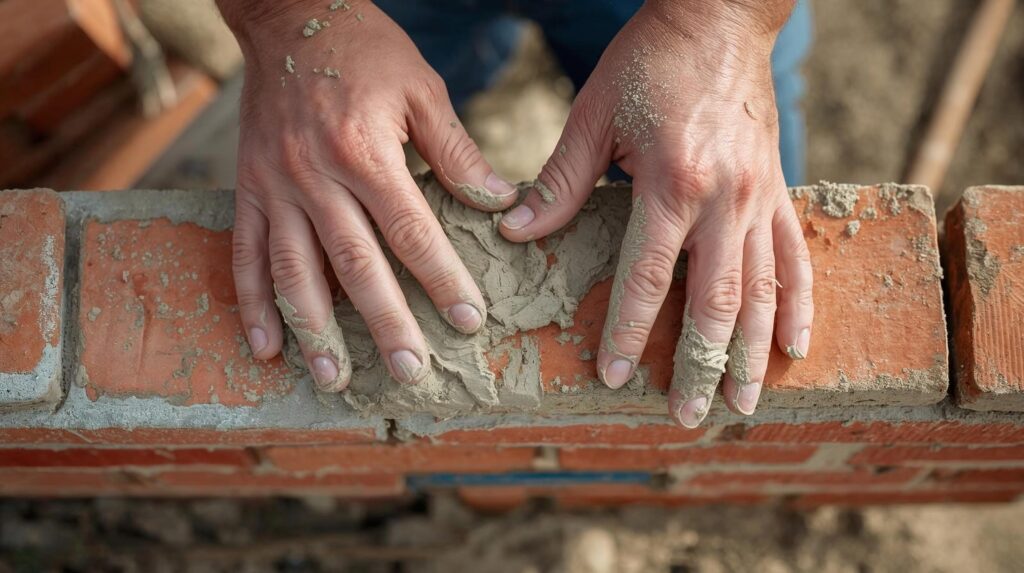
Once your mortar is mixed, the building process is straightforward:
- Prepare your site: Clear a flat area and dig a shallow trench (6-12 inches deep) for your foundation. Fill it with gravel or compacted dirt for drainage.
- Lay your first course: Place your first layer of stones, bricks, or wood posts. You can set them dry or use a small amount of mortar to stabilize them.
- Apply mortar: Spread about 1/2 inch of mortar on top of each piece before adding the next layer. Press down gently and tap with a rock or stick to level.
- Fill gaps: Use extra mortar to fill spaces between stones or bricks. Smooth with your fingers or a stick.
- Cover while curing: Drape a tarp over your work at the end of each day. This keeps rain off and slows drying, which prevents cracks.
Tools that help: A basic mason’s trowel makes spreading easier, but your hands or a flat stick work fine too.
Step 5: What You Can Build
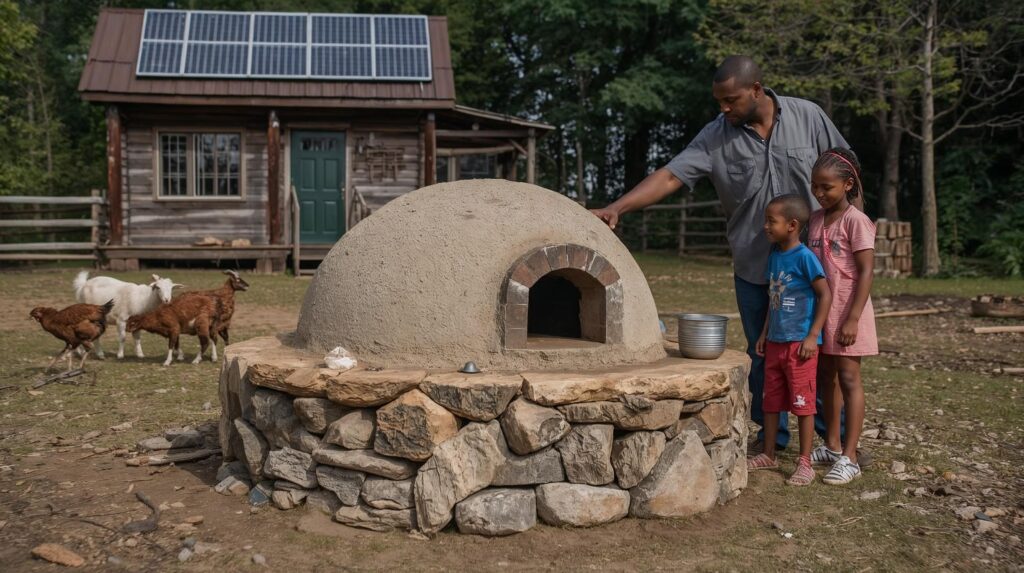
Once you’ve got the mortar basics down, the possibilities open up. Here are a few projects people commonly tackle:
- Fire pits: Mortar stones in a circle for efficient, long-lasting campfires
- Smokers or BBQ pits: Build a stone box with a grate for smoking meat
- Tool sheds: Use mortar to set stone or brick walls, or anchor wood posts
- Garden walls: Low borders for raised beds or terracing
- Small ovens: Stone pizza ovens or baking chambers
Once you’ve got a solid outdoor smoker or BBQ pit built, pair it with quality off-grid cooking equipment to make the most of your setup.
I’ll be covering specific build instructions for these projects in future articles. For now, the important thing is getting comfortable with making and using mortar. Once you’ve done that, the building part is just stacking and patience.
Tips for Success
Safety: Wear gloves if working with lime. Build fire pits away from dry grass or structures.
Fixes: Cracks forming? Add more straw next batch. Too dry and crumbly? More clay. Too wet? More sand. Mortar not sticking to wood? Thicken it up and rough up the wood surface first.
Maintenance: Check your projects each year and patch any cracks with fresh mortar. For extra weather protection, brush on a thin layer of watery clay as a seal.
Helpful tools: A tarp for mixing, a shovel, and a trowel speed things up, but they’re not required. You can do this entire process with your hands and basic items you already own.
You’re Ready to Start
Natural mortar isn’t complicated—it’s just clay, sand, and water mixed to the right consistency. You dig a little, mix on a tarp, and build. The techniques I’ve shared here have worked for centuries, and they’ll work for your off-grid projects too.
Start small with Recipe 1. Make a batch, test it by stacking a few stones, and see how it dries over a week. Once you’re comfortable, scale up to whatever project calls to you. The hardest part is just starting—after that, you’ll wonder why more people don’t do this.

